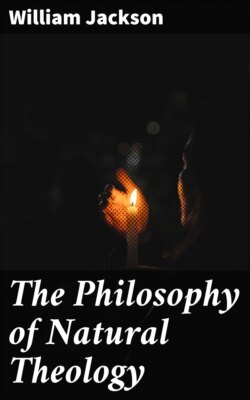Читать книгу The Philosophy of Natural Theology - William Jackson T. - Страница 12
На сайте Литреса книга снята с продажи.
E.—ON THE EFFECT OF CONSILIENT PROOFS.
ОглавлениеThe expressive word "Consilience" has been adopted on the authority of Dr. Whewell and Professor Pritchard, both of whom employ it in preference to the commoner expression convergence. Upon the force of consilient proofs, Dr. Whewell writes thus:—
"The cases in which inductions from classes of facts altogether different have jumped together, belong only to the best established theories which the history of science contains. And as I shall have occasion to refer to this peculiar feature in their evidence, I will take the liberty of describing it by a particular phrase, and will term it the Consilience of Inductions.
"It is exemplified principally in some of the greatest discoveries. Thus it was found by Newton that the doctrine of the attraction of the sun varying according to the inverse square of the distance, which explained Kepler's Third Law of the proportionality of the cubes of the distances to the squares of the periodic times of the planets, explained also his First and Second Laws of the elliptical motion of each planet; although no connexion of these laws had been visible before. Again, it appeared that the force of universal gravitation, which had been inferred from the perturbations of the moon and planets by the sun and by each other, also accounted for the fact, apparently altogether dissimilar and remote, of the precession of the equinoxes. Here was a most striking and surprising coincidence, which gave to the theory a stamp of truth beyond the power of ingenuity to counterfeit....
... The theory of universal gravitation, and of the undulatory theory of light, are indeed full of examples of this consilience of inductions. With regard to the latter, it has been justly asserted by Herschel, that the history of the undulatory theory was a succession of felicities. And it is precisely the unexpected coincidences of results drawn from distant parts of the subject which are properly thus described." ("Philosophy of the Inductive Sciences," B. XI., chap. v., s. 3.)
And again, "It is true, the explanation of one set of facts may be of the same nature as the explanation of the other class; but then, that the cause explains both classes, gives it a very different claim upon our attention and assent from that which it would have if it explained one class only. The very circumstance that the two explanations coincide, is a most weighty presumption in their favour. It is the testimony of two witnesses in behalf of the hypothesis; and in proportion as these two witnesses are separate and independent, the conviction produced by their agreement is more and more complete. When the explanation of two kinds of phenomena, distinct, and not apparently connected, leads us to the same cause, such a coincidence does give a reality to the cause, which it has not while it merely accounts for those appearances which suggested the supposition. This coincidence of propositions inferred from separate classes of facts, is exactly what we noticed in the last book, as one of the most decisive characteristics of a true theory, under the name of Consilience of Inductions.
"That Newton's first rule of philosophizing, so understood, authorizes the inferences which he himself made, is really the ground on which they are so firmly believed by philosophers. Thus, when the doctrine of a gravity varying inversely as the square of the distance from the body, accounted at the same time for the relations of times and distances in the planetary orbits and for the amount of the moon's deflection from the tangent of her orbit, such a doctrine became most convincing: or, again, when the doctrine of the universal gravitation of all parts of matter, which explained so admirably the inequalities of the moon's motions, also gave a satisfactory account of a phenomenon utterly different—the precession of the equinoxes. And of the same kind is the evidence in favour of the undulatory theory of light, when the assumption of the length of an undulation, to which we are led by the colours of thin plates, is found to be identical with that length which explains the phenomena of diffraction; or when the hypothesis of transverse vibrations, suggested by the facts of polarization, explains also the laws of double refraction. When such a convergence of two trains of induction points to the same spot, we can no longer suspect that we are wrong. Such an accumulation of proof really persuades us that we have to do with a vera causa. And if this kind of proof be multiplied,—if we again find other facts of a sort uncontemplated in framing our hypothesis, but yet clearly accounted for when we have adopted the supposition,—we are still further confirmed in our belief, and by such accumulation of proof we may be so far satisfied as to believe without conceiving it possible to doubt. In this case, when the validity of the opinion adopted by us has been repeatedly confirmed by its sufficiency in unforeseen cases, so that all doubt is removed and forgotten, the theoretical cause takes its place among the realities of the world, and becomes a true cause." (Ibid. B. XII., chap. xiii., art. 10.)
The reader of this Essay will be pleased to remark as he proceeds that its argument is made up of a diversity of proofs (very many among them being inductive), and that they all lend each other mutual support and become consilient at last.
